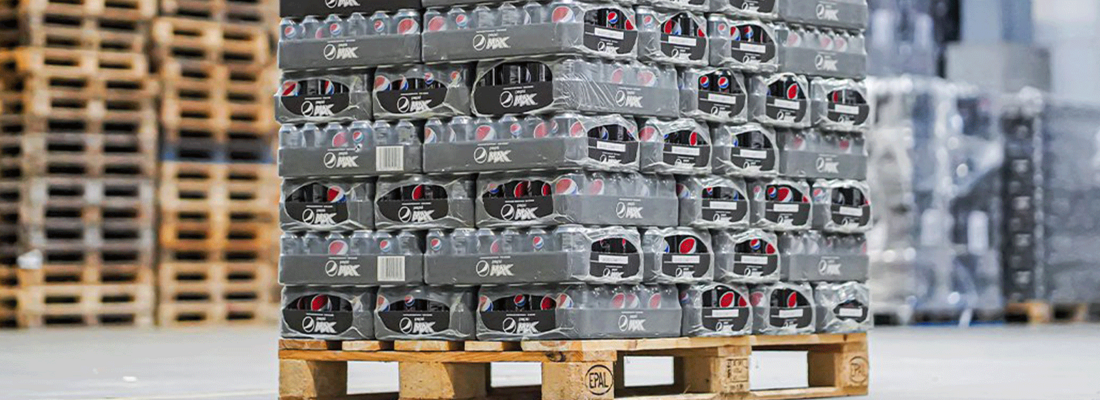In its consistent efforts to create a world in which plastics never become waste, the company PepsiCo has succeeded in taking a forward-looking step: For the first time, the packaging film for Pepsi bottles was tested in a test project with the Green Dot and cans made from 10% recycled plastic from the Yellow Bag, 40% recycled plastic from other sources, and only half virgin plastic. If further quality tests are just as successful, the next goal is to convert regular production to film from film.
As early as October 2021, a full 100 days ahead of schedule, PepsiCo switched to 100% recycled plastic (rPET) for all carbonated beverage bottles and the Lipton Icetea range. Bottles and beverage cans are usually sold in so-called shrink film in packs of six, which in turn are on pallets. For safe transport, the six-packs are wrapped with meter-long pallet film. All new plastic. The high quality of the packaging film, which is customary in the industry, results from the need for stability and the desire to print on it. "It's a charming way of attracting the attention of consumers and differentiating oneself, as well as an expression of our quality standards in design and therefore an important marketing tool," saysKai Klicker-Brunner, Head of Corporate Affairs and part of the management of PepsiCo Germany . “But they end up in the garbage very quickly. That's why we commissioned our film suppliers to develop a recycled version for us." The supplier turned to the Green Dot, which, among other things, has set up the separate collection of used sales packaging in Germany and is now one of the leading plastics recyclers.
Promising first attempt with recycled film
The pilot test at the beginning of December 2021 at the Pepsiwerk Niederroden Trials on the packaging lines for 0.33 liter cans and 1.5 liter PET bottles was a pioneering success: 50% of the container films in the test run were made from recycled material. One fifth of the recycled LDPE (Low Density Polyethylene, soft polyethylene) in the shrink film has been replaced with recyclate from the Yellow Bag. "That's a great result," said Kai Klicker-Brunner . "If the packaging also passes further tests, that would be the starting signal to change our production." Although it would be easier to continue using virgin plastic.
PepsiCo is already a pioneer in its industry and is approaching its own ambitious goal of halving the amount of untreated plastic per serving in the entire food and beverage portfolio by 2030 as part of the PepsiCo Positive sustainability agenda.
A new process increases the quality of the plastic
To understand the groundbreaking importance of this pilot project, one has to know that up to a quarter of the packaging waste in the yellow bag or bin in Europe consists of foil. Systec Plastics Eisfeld has been recycling these for a long time. But that is a huge effort for the subsidiary of the Green Dot. "Foil has a very large surface and therefore absorbs dirt like a sponge, always remains grey, smells bad even after cleaning and is not as dense as, for example, the hard plastic of a yoghurt cup," explains Der Grüne Punkt Press Officer Norbert Völl. While more than half of the plastic waste in the yellow sack is turned into high-quality new recycling products, including packaging for detergents, cleaning agents and detergents, for example, the films are only made into simple products such as construction buckets or lawn grids. "That wasn't enough for us, so we developed a new process."
The foils sorted out are cleaned and shredded after quality control. These pieces of plastic go into a kind of meat grinder called an extruder, are melted and a granulate comes out. "This new recyclate, which we call Systalen, can be used to make much higher-quality products, including flexible packaging," says Norbert Völl . This development is just beginning. The 10% initially added to the film should gradually increase. The goal is clean material for new, stable foils. "In view of the huge amounts of film, there is enormous potential here," say Völl and Michael Wiener, the managing directors of Duales System Holding . adds: "When a customer like PepsiCo is the first to use this material in an application as important as six-pack film, that's a really bold move."
Drink enjoyment with a good feeling
In the future, the packaging film will no longer look as clear and bright as before. "But if people know and understand why the packaging looks different, they'll definitely be happy to accept it," says PepsiCo 's Kai Klicker-Brunner . Especially when enjoying the drink is combined with the good feeling of doing something positive for our planet.
Stage victory for the circular economy
The shrink film pilot project is an important milestone. PepsiCo Europe is committed to setting ambitious recycling targets for flexible plastic packaging across Europe. The company is also pushing for the expansion of landfill bans and the rapid introduction of EPR (Extended Producer Responsibility) fees across Europe to drive the collection, sorting and recycling of flexible films and ultimately the development of a circular economy for flexible plastics. PepsiCo is also investing in technology to further improve sorting and recycling and is part of Holy Grail 2.0, a digital watermarking consortium. The initiative wants to advance intelligent packaging sorting and recycling at European level.







